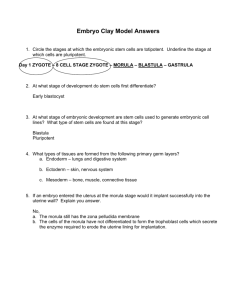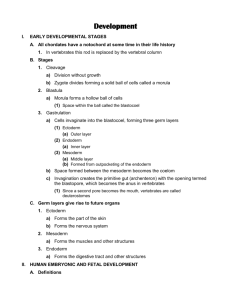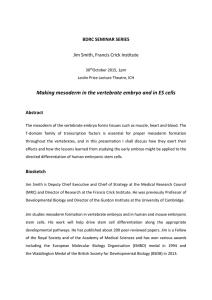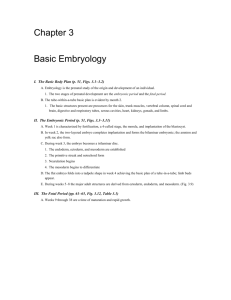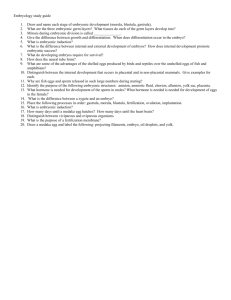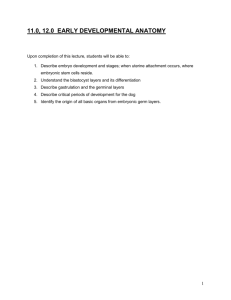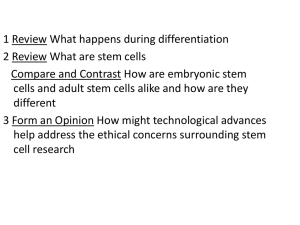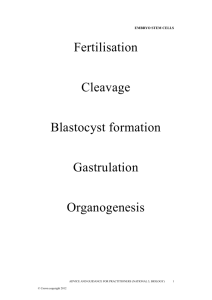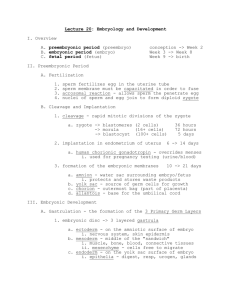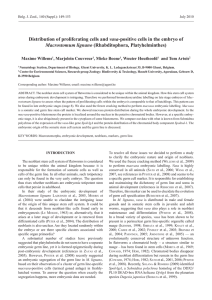Development Vocabulary
advertisement
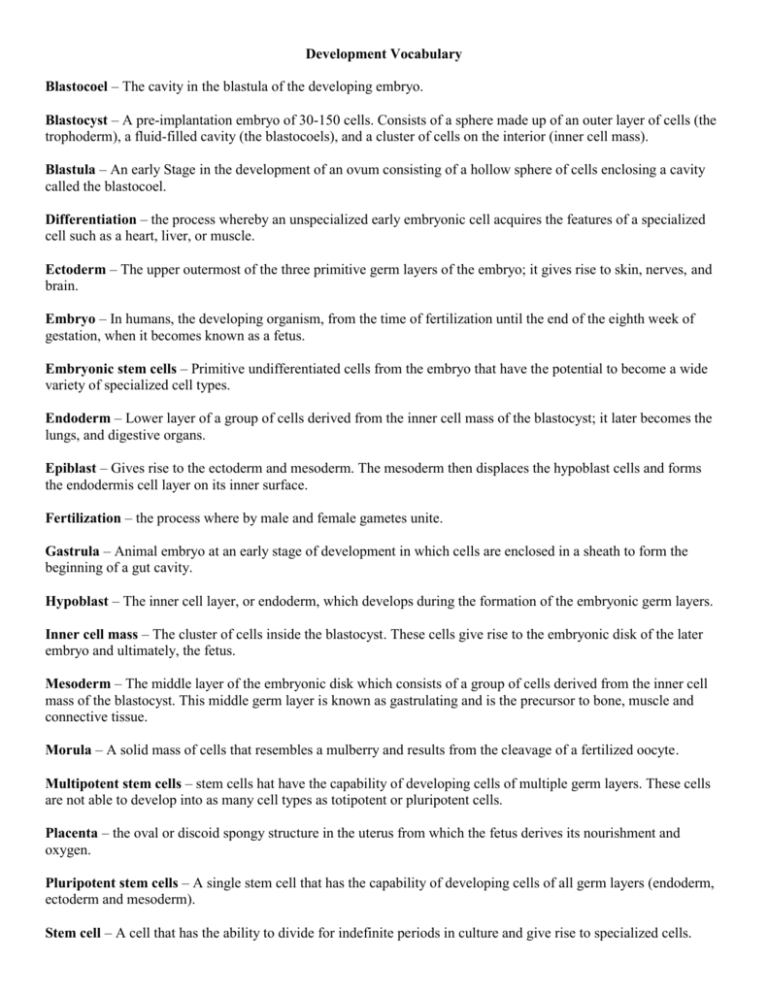
Development Vocabulary Blastocoel – The cavity in the blastula of the developing embryo. Blastocyst – A pre-implantation embryo of 30-150 cells. Consists of a sphere made up of an outer layer of cells (the trophoderm), a fluid-filled cavity (the blastocoels), and a cluster of cells on the interior (inner cell mass). Blastula – An early Stage in the development of an ovum consisting of a hollow sphere of cells enclosing a cavity called the blastocoel. Differentiation – the process whereby an unspecialized early embryonic cell acquires the features of a specialized cell such as a heart, liver, or muscle. Ectoderm – The upper outermost of the three primitive germ layers of the embryo; it gives rise to skin, nerves, and brain. Embryo – In humans, the developing organism, from the time of fertilization until the end of the eighth week of gestation, when it becomes known as a fetus. Embryonic stem cells – Primitive undifferentiated cells from the embryo that have the potential to become a wide variety of specialized cell types. Endoderm – Lower layer of a group of cells derived from the inner cell mass of the blastocyst; it later becomes the lungs, and digestive organs. Epiblast – Gives rise to the ectoderm and mesoderm. The mesoderm then displaces the hypoblast cells and forms the endodermis cell layer on its inner surface. Fertilization – the process where by male and female gametes unite. Gastrula – Animal embryo at an early stage of development in which cells are enclosed in a sheath to form the beginning of a gut cavity. Hypoblast – The inner cell layer, or endoderm, which develops during the formation of the embryonic germ layers. Inner cell mass – The cluster of cells inside the blastocyst. These cells give rise to the embryonic disk of the later embryo and ultimately, the fetus. Mesoderm – The middle layer of the embryonic disk which consists of a group of cells derived from the inner cell mass of the blastocyst. This middle germ layer is known as gastrulating and is the precursor to bone, muscle and connective tissue. Morula – A solid mass of cells that resembles a mulberry and results from the cleavage of a fertilized oocyte. Multipotent stem cells – stem cells hat have the capability of developing cells of multiple germ layers. These cells are not able to develop into as many cell types as totipotent or pluripotent cells. Placenta – the oval or discoid spongy structure in the uterus from which the fetus derives its nourishment and oxygen. Pluripotent stem cells – A single stem cell that has the capability of developing cells of all germ layers (endoderm, ectoderm and mesoderm). Stem cell – A cell that has the ability to divide for indefinite periods in culture and give rise to specialized cells. Totipotent – Having unlimited capability. The totipotent cells of the very early embryo have the capacity to differentiate into extra embryonic membranes and tissues, the embryo, and all postembryonic tissues and organs. Trophoderm – The outer layer of the developing blastocyst that will ultimately form the embryonic side of the placenta. Trophoblast – the extra embryonic tissue responsible for negotiating implantation, developing into the placenta, and controlling the exchange of oxygen and metabolites between mothers and embryo. Yolk sac – Vital to the formation of primordial and other cells that form the embryo. In mammals, it is small and devoid of yolk. Zona pellucida – A thick, transparent non-cellular layer that surrounds and protects the oocyte. Zygote – A cell formed by the union of male and female germ cells (sperm and egg, respectively). Embryo Model Questions Circle the stages at which the embryonic stem cells are totipotent. Underline the stages at which cells are pluripotent. Do nothing below if the stage is multipotent. o Day 1 ZYGOTE – 8 CELL STAGE ZYGOTE – MORULA – BLASTULA – GASTRULA At what stage of development do stem cells first differentiate? At what stage of embryonic development are stem cells used to generate embryonic stem cell lines. Which type of stem cells is found at this stage? What types of tissues are formed from the following primary germ layers? Endoderm Ectoderm Mesoderm If an embryo entered the uterus at the morula stage would it implant successfully into the uterine wall? Explain you answer.
